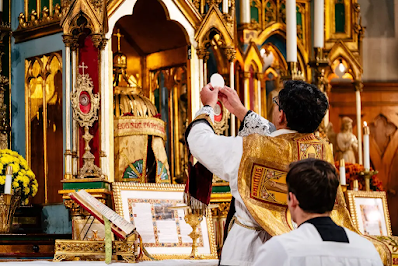Old Latin Mass Finds New American Audience, Despite Pope’s Disapproval
An ancient form of Catholic worship is drawing in young traditionalists and conservatives. But it signals a divide within the church.
By Ruth Graham
The New York Times
Nov. 15, 2022
DETROIT — Eric Agustin’s eight children used to call the first day of the week “Party Sunday.” The family would wake up, attend a short morning Mass at a Catholic parish near their house, then head home for lunch and an afternoon of relaxing and watching football.
But this summer, the family made a “big switch,” one of his teenage sons said on a recent Sunday afternoon outside St. Joseph Shrine, the family’s new parish. At St. Joseph, the liturgy is ornate, precisely choreographed and conducted entirely in Latin. The family drives an hour round trip to attend a service that starts at 11 a.m. and can last almost two hours.
The traditional Latin Mass, an ancient form of Catholic worship that Pope Francis has tried to discourage, is instead experiencing a revival in the United States. It appeals to an overlapping mix of aesthetic traditionalists, young families, new converts and critics of Francis. And its resurgence, boosted by the pandemic years, is part of a rising right-wing strain within American Christianity as a whole.
...Latin Mass adherents tend to be socially conservative and tradition-minded. Some, like the Augustin family, are attracted to the Mass’s beauty, symbolism and what they describe as a more reverent form of worship....The traditional Latin Mass, also referred to as the “extraordinary form,” was celebrated for centuries until the transformations of the Second Vatican Council in the 1960s, which were intended in part to make the rite more accessible. After the Council, Mass could be celebrated in any language, contemporary music entered many parishes and priests turned to face people in the pews.But the traditional Latin Mass, with all its formality and mystery, never fully disappeared. Though it represents a fraction of Masses performed at the 17,000 Catholic parishes in the United States, it is thriving.The United States now appears to have at least 600 venues offering the traditional Mass, the most by far of any country. More than 400 venues offer it every Sunday, according to one online directory.This growth is happening as Pope Francis has cracked down, issuing strict new limits on the rite last year. His immediate predecessor, Pope Benedict XVI, had widened access to the old Mass, but Francis has characterized it as a source of division in the church and said that it is too often associated with a broader rejection of the aims of the Second Vatican Council.On one level, the split over the old Mass represents a clash of priorities and power struggles in church leadership. In pews and parishes, it is more complicated. Many Catholics say they are attracted to the Mass for spiritual reasons, bolstered by aesthetic and liturgical preferences rather than by partisanship....“It’s nothing exceptional here,” demurred Rev. Canon J.B. Commins, 33, who lives in the brick rectory next door. “In other places where the traditional Mass is being celebrated, it’s exponential growth.”Leaning into the demands of intense religious experience, many supporters of the Latin Mass seek a return not just to old rituals but to old social values and gender roles. Here, the arcane and rigorous are not barriers to accessibility but attractions that tie believers to a long history of spiritual clarity, which they see as sharply contrasting with the modern church.The pandemic accelerated the divide, as mainstream parishes generally stayed closed longer, driving some Catholics to seek out new parishes. Many attendees say they discovered traditionalist podcasters and influencers who turned them onto the older Mass....Political and theological conservatives see in Pope Francis’s restriction of the traditional Latin Mass a troubling disregard for orthodoxy more broadly....Francis’s 2021 document “Traditionis Custodes,” comparable to an executive order, limited where and when the old Mass can be celebrated. And this summer, he outraged traditionalists further with a new document making clear that the tensions around the Mass are more than a question of taste. “I do not see how it is possible to say that one recognizes the validity of the Council — though it amazes me that a Catholic might presume not to do so — and at the same time not accept the liturgical reform,” he wrote.The crackdown helped fuel what some call the “liturgy wars.”...“It’s something I couldn’t imagine, having to beg and plead for the traditional Latin Mass,” said Noah Peters, who organized a five-mile “pilgrimage” in September from a cathedral in Arlington, Va., to one in Washington in protest of the restrictions in both dioceses.Mr. Peters was raised as a secular Jew and was drawn to Catholicism through the traditional Latin Mass “because it had this beauty, timelessness and reverence about it,” he said....Mr. Begin sees Pope Francis’s antagonism toward the Latin Mass as working against his goal of unity. “You’re going to drive people to breakaway groups,” he said.At Old St. Mary’s, a 19th-century parish in the city’s touristy Greektown neighborhood, some 150 people gathered in October for the monthly Latin Mass service, complete with a Gregorian choir.Congregants knelt, rose, crossed themselves and murmured prayers. Incense wafted through the vast, dimly lit room. When it was time to receive the Eucharist, they filed silently forward and knelt, their faces slightly upturned.“Corpus Dómini nostri Jesu Christi custódiat ánimam tuam in vitam ætérnam. Amen,” the priests prayed as they placed a thin wafer on each tongue. May the Body of Our Lord Jesus Christ preserve your soul unto life everlasting. Amen.
...
